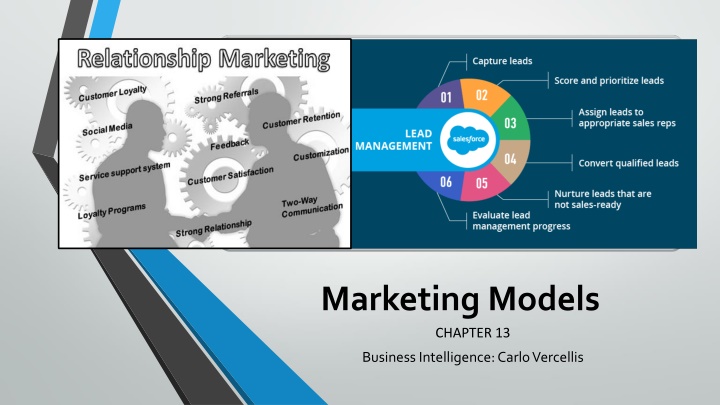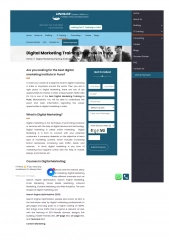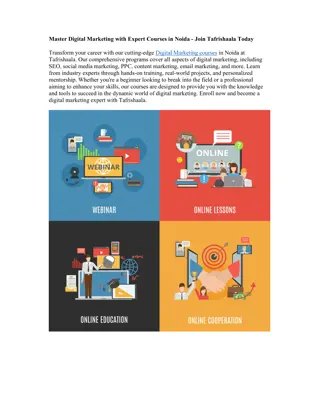
Marketing Models
In the realm of business intelligence and relational marketing, companies utilize data analysis to enhance customer relationships and drive sustainable competitive advantages. This involves understanding customer behavior, personalized interactions, and long-term relationship building. By adopting relational marketing strategies, businesses can boost customer satisfaction, increase profits, and achieve mutually beneficial outcomes. Additionally, the comparison between relational marketing and CRM highlights the importance of building trust, engaging customers, and utilizing data for targeted marketing efforts.
Download Presentation

Please find below an Image/Link to download the presentation.
The content on the website is provided AS IS for your information and personal use only. It may not be sold, licensed, or shared on other websites without obtaining consent from the author. If you encounter any issues during the download, it is possible that the publisher has removed the file from their server.
You are allowed to download the files provided on this website for personal or commercial use, subject to the condition that they are used lawfully. All files are the property of their respective owners.
The content on the website is provided AS IS for your information and personal use only. It may not be sold, licensed, or shared on other websites without obtaining consent from the author.
E N D
Presentation Transcript
Marketing Models CHAPTER 13 Business Intelligence: Carlo Vercellis
Relational Marketing Initiate, strengthen, intensify and preserve over time the relationship between the company and the stakeholder Insurance companies for selecting marketing segment for a new type of policy Mobile Phone provider identify customers with highest probability of churning Bank-for issuing credit cards for a group of customers. (identify the group)
Relational Marketing -Objectives Increase growth of customers complexity Increased marketing activities customization E-Commerce global comparison Customer loyalty uncertain Progressive commoditization of products - differentiation is mainly due to levels of service Large amounts of sales data that can be transformed into knowledge The number of competitors using advanced techniques for the analysis of marketing data has increased.
Relational Marketing The ability to effectively exploit the information gathered on customers behavior represents today a powerful competitive weapon for an enterprise. A company capable of gathering, storing, analyzing and understanding the huge amount of data on its customers can base its marketing actions on the knowledge extracted and achieve sustainable competitive advantages. Enterprises may profitably adopt relational marketing strategies to transform occasional contacts with their customers into highly customized long-term relationships. In this way, it is possible to achieve increased customer satisfaction and at the same time increased profits for the company, attaining a win win relationship.
Relational Marketing v/s CRM Relationship marketing - a sales and marketing concept, CRM - tools used to carry out the concept. Relationship marketing - implemented as a strategy and includes activities such as identifying long-term sales and retention goals, public relations, marketing and advertising campaigns. CRM - operational tasks that support the relationship marketing strategy. Acitivities may include gathering data about the customers, then organizing and analyzing it to create target customer profiles. RM to CRM - Relationship marketing - increase sales by building trust and engaging customers; CRM system - allows a salesperson to quickly and consistently deliver what customers are looking for with each and every interaction, because their preferences and buying history are recorded. CRM to RM -The system benefits the customers, because they see the business "knows" them. CRM systems coordinate, automate and deliver online and offline advertising and marketing activities that help build the long-term customer relationships that are crucial to a successful relationship marketing strategy.
Examples -Network of relationships The manufacturers of consumer goods, available at the points of sale of large and small retailers, do not have direct information on the consumers purchasing their products. The manufacturers of goods covered by guarantees, such as electrical appliances or motor vehicles, have access to personal information on purchasers, even if they rarely also have access to information on the contacts of and promotional actions carried out by the network of dealers. A savings management company usually places shares in its investment funds through a network of intermediaries, such as banks or agents, and often knows only the personal data of the subscribers. A pharmaceutical enterprise producing prescription drugs usually ignores the identity of the patients that use its drugs and medicinal products, even though promotional activities to influence consumers are carried out in some countries where the law permits.
B2B Few customers of high value in contact personally B2C Many customers of low value impersonal contact websites, point of sale.
Life time of a customer Acquisition - identification of new prospects Retention -maturity stage ; retain customers. It has been empirically observed that the cost of acquiring a new customer, or winning back a lost customer, is usually much higher of the order of 5 to 9 times higher than the cost of the marketing actions aimed at retaining customers considered at risk of churning. Cross-selling Up-selling
Market basket analysis The purpose is to gain insight from the purchases made by customers in order to extract useful knowledge to plan marketing actions. Mostly used to analyze purchases in the retail industry and in e-commerce activities. Data purchase transactions data associated with the time dimension. Each transaction consists of a list of purchased items- called a basket. Transactions to be connected -If transactions cannot be connected to one another; apply association rules
SalesForceManagement Salesforce - whole set of people and roles that are involved, with different tasks and responsibilities, in the sales process. Salesforce Automation -use of software tools Residential Sales :-Takes place at one or more sites managed by a company supplying some products or services, where customers go to make their purchases. This category includes sales at retail outlets as well as wholesale trading centers and cash-and-carry shops. Mobile Sales :-agents of the supplying company go to the customers homes or offices to promote their products and services and collect orders. Telephone sales :-are carried out through a series of contacts by telephone with prospective customers.
SalesForceManagement (Mobile Sales) designing the sales network; planning the agents activities; contact management; sales opportunity management; customer management; activity management; order management; area and territory management; support for the configuration of products and services; knowledge management with regard to products and services
Decision processes
Sales Design
Business case studies Retention in telecommunications SCENARIO :- Mobile telephone industry were the first to use learning models and data mining methods to support relational marketing strategies. One of the main objectives has been customer retention, also known as churn analysis. The effect of market saturation and strong competition have combined to cause instability and disaffection among consumers, who can choose a company based on the rates, services and access methods that they deem most convenient. This phenomenon is particularly critical with regard to prepaid telephone cards, very popular in the mobile phone industry today, as they make changing a telephone service provider quite easy and of little cost.
Retention in telecommunications Company and objectives A mobile phone company wishes to model its customers propensity to churn A predictive model able to associate each customer with a numerical value (or score) that indicates their probability of discontinuing service, based on the value of the available explanatory variables. The model should be able to identify, based on customer characteristics, homogeneous segments relative to the probability of churning, In order to later concentrate on these groups the marketing actions to be carried out for retention, thus reducing attrition and increasing the overall effectiveness.
Retention in telecommunications Data for constructing predictive model customer type (business or private); telephone card type (subscription or prepaid); years of service provision, whether above or below a given threshold; area of residence. personal information (socio-demographic); administrative and accounting information; incoming and outgoing telephone traffic, subdivided by period (weeks or months) and traffic direction; access to additional services, such as fax, voice mail, and special service numbers; calls to customer assistance centers; notifications of malfunctioning and disservice; emails and requests through web pages.
Retention in telecommunications Analysis and results Once the dataset for developing the models has been extracted from the data mart, a detailed exploratory analysis can be carried out. On the one hand, it shows a certain number of anomalies, in the form of outliers and missing values, whose removal improves the quality of data. On the other hand, additional variables can be generated through appropriate transformations in order to highlight relevant trends and correlations identified by exploratory data analysis. After applying feature reduction and extraction, the new dataset contains about 150 predictive variables, after the addition of derived variables and removal of some original variables deemed uninfluential on the target. An indicator variable is defined to denote churning by a customer in cases where official notification of service discontinuation is not required, as is the case for prepaid cards. For example, if a private customer makes fewer outgoing calls than a preset threshold and receives a number of incoming calls that is below a second threshold value, she is believed to be at a churning stage.
Business case studies Acquisition in the automotive industry A company manufacturing industrial vehicles wishes to develop a predictive model that can assign to each prospect a score that indicates his propensity to positively respondto a marketing action aimed at acquisition. The main purpose of the model is to provide guidance for promotion actions carried out by the network of dealers. Refine the knowledge of the customer base and of the market scenarios, and identifying the distinctive features that characterize current customers in order to design initiatives directed to stimulate new acquisitions.
Acquisition in the automotive industry Analysis and results Prospects and customers. The first group of data concerns current or potential customers of the company, including customers owning vehicles not necessarily produced by the company. Besides demographic information, the data include 15 explanatory variables that gather meaningful information, such as the top-rated type of vehicle owned by each prospect, the number of new and used vehicles produced by competitors and owned by each prospect, and the number of new and used vehicles bought in the past by each prospect. Vehicles. The second group of data includes 16 attributes that enable the vehicles owned by each prospect to be identified, among them model, weight class, optional features, fuel type, first and last registration date and status (new or used vehicle). These attributes define for each vehicle the timing of sales transactions, or transfers of ownership. Works. The third group of data refers to maintenance and repair work undergone by the vehicles during the warranty period and beyond. In particular, these data indicate the type of work carried out, a description of the problem, the vehicle mileage at the time of service, the car shop where the repair was carried out and the date of admission and release of the vehicle to and from the shop.
Business case studies Cross-selling in the retail industry Segment its customer base in order to optimize marketing actions aimed at promoting a specific product or group of products. The goal is therefore to develop a predictive model able to assign to each customer a score that indicates her propensity to respond positively to a cross-selling offer. Besides prediction purposes, the model should be used also to interpret explanatory factors that have a greater effect on the purchase of the product promoted. Finally, the model is to be used for assessing the existence of causal and temporal correlations between the purchase of the product promoted and the purchase of other items.
Cross-selling in the retail industry Analysis and results personal information (socio-demographic); date of signing up for the loyalty card, which can be regarded as the starting date for the relationship between customer and company; dates of first and last purchase, marking the boundary of the time interval within which purchases have been made by each individual customer; cash slips, indicating which items, and in what quantities, have been purchased by each customer; purchases of sale items made by each customer; participation in point-earning programs and related prizes won;






















